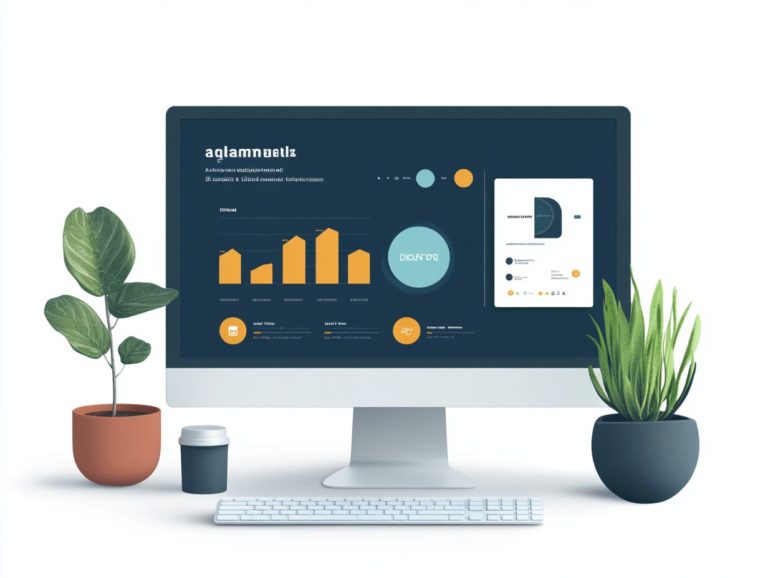How Do I Create Compelling Calls to Action?
In the digital landscape, a compelling call to action (CTA) can be the pivotal factor that turns a casual visitor into a devoted customer.
By grasping the essential elements that make CTAs effective such as precise messaging, impactful action words, and thoughtful placement you can significantly enhance your conversion rates.
This article delves into the significance of CTAs, guides you on how to craft them for different platforms, and outlines best practices for testing their effectiveness.
Are you ready to boost user engagement? Continue reading!
Contents
Key Takeaways:

- A compelling CTA is crucial for converting potential customers into actual buyers or subscribers.
- A clear and concise message, strong action words, and strategic placement and design are essential elements of an effective CTA.
- When creating CTAs for different platforms, such as websites, social media, and email marketing, it’s important to follow best practices and adapt to the specific platform’s audience and format.
The Importance of Calls to Action
Calls to action (CTAs) are essential components of your marketing strategy, serving as powerful tools to drive user engagement and conversions across platforms like websites, email marketing, and social media posts. They establish a direct connection between your business and its target audience, fostering lead generation and ultimately propelling growth.
An effective CTA uses the ability of emotional copywriting and creates a sense of urgency, compelling users to act without delay. This enriches the customer experience and aligns seamlessly with your business objectives, ensuring that every interaction is purposeful and impactful.
Why CTAs are Essential for Conversions
CTAs are crucial for driving conversions, acting as the pivotal intersection where user engagement meets marketing effectiveness. They invite you to take action, whether it’s signing up for newsletters or making that all-important purchase.
These calls to action guide you through your customer journey and enhance promotional messaging by clearly outlining the next steps. A simple button that says ‘Get Started Today’ can spark your interest and prompt immediate action. A more enticing option like ‘Unlock Your Exclusive Offer’ brings an added sense of urgency and exclusivity.
By strategically placing these phrases throughout a website or email campaign, businesses can significantly influence conversion rates, transforming you from a passive visitor into an eager participant ready to engage with the brand’s offerings.
Elements of a Compelling Call to Action
Crafting a compelling call to action requires a mix of key elements that attract your target audience. Start with clear messaging that cuts through the noise, accompanied by strong action words that inspire immediate response. For more insights on this topic, check out how to create compelling CTAs for higher conversions. Strategic placement is equally crucial to ensure your call to action is positioned where it can’t be missed.
Consider incorporating action-oriented language that aligns with user preferences, alongside pricing details or unique selling points that instill a sense of urgency. By skillfully leveraging these components, you can amplify excitement and motivate users to engage deeply with your marketing materials.
Clear and Concise Messaging
Clear and concise messaging is essential when crafting a successful call to action. It should encapsulate the desired action in a straightforward way, utilizing actionable language that resonates with your behavior and preferences.
This focus on clarity drives immediate action and builds trust and understanding, which are crucial in your decision-making journey. To enhance effectiveness, consider using verbs that inspire immediate action, like “Discover,” “Join,” or “Get Started.”
Incorporating a sense of urgency, such as “Limited Time Offer,” can prompt quicker responses. Tailoring the message to reflect your needs boosts engagement and aligns with your intentions, making it more likely that you’ll follow through with the desired action.
Ultimately, a clear call to action bridges the gap between intention and action, simplifying your experience and guiding you smoothly toward your goals.
Start crafting your CTAs today and watch your conversions soar!
Strong Action Words

Utilizing strong action words in your calls to action can significantly enhance their effectiveness. Phrases like “Call today” or “Get your discount now” create a sense of urgency that prompts users to respond immediately.
Use dynamic verbs to guide users towards actions. For example, “Discover your potential” or “Join our community” resonate well and make audiences feel like an integral part of a larger narrative.
These compelling calls encourage engagement and foster a deeper connection to your brand. Strong verbs such as “Unlock,” “Explore,” and “Transform” evoke emotions and inspire action in potential customers, aligning with your marketing objectives while addressing user interests.
Placement and Design
The placement and design of your calls to action (CTAs) are crucial elements that significantly impact visibility and user engagement. By positioning CTAs strategically on your landing pages and ensuring they stand out, you can achieve notably higher conversion rates.
In a digital landscape saturated with choices and distractions, this becomes even more vital. Use contrasting colors, captivating fonts, and clear messaging to capture attention effectively. Ensure that your CTAs align with user intent, whether nestled within a blog post, featured in an email campaign, or showcased on social media.
For instance, embedding a prominent CTA within an email can prompt immediate action. Placing it at the beginning or end of social media posts bolsters visibility. Thoughtfully designing and positioning your calls to action cultivates a more engaging user experience that encourages conversions across various channels.
Creating Effective CTAs for Different Platforms
Crafting compelling calls to action requires understanding the distinct dynamics of each platform be it a website, social media, or email marketing. Tailor your CTAs to align with how users interact with each medium to elevate their effectiveness and drive desired results.
Best Practices for Websites
- Prominently display your CTA.
- Use persuasive language.
- Create a seamless user experience that guides visitors toward lead generation.
Beyond placement, the color and size of your CTA button are critical in capturing attention. Using contrasting colors against your website’s background enhances visibility.
Emotional copywriting is your secret weapon, tapping into users’ feelings. Highlight benefits such as urgency or exclusivity. Phrases like “Join Now for Exclusive Offers!” give visitors the nudge they need to engage.
Analyzing user behavior with tools like heatmaps which show where users click most gives you the power to optimize CTA placement for maximum impact. This strategy transforms casual browsers into loyal customers!
CTAs for Social Media
Your social media CTAs should spark engagement and interaction, prompting users to share content or dive into promotional campaigns. Customize the language and visuals in your CTAs to resonate with your target audience.
Action-oriented phrases like “Join the conversation!” or “Get your discount now!” create urgency and excitement, compelling users to act.
Incorporate eye-catching designs with contrasting colors to draw attention to your CTAs, ensuring they stand out in users’ feeds. Analyzing user behavior shows that CTAs paired with captivating visuals such as images and videos boost click-through rates.
A compelling Facebook post featuring a clear CTA can lead to increased shares and interactions. Leverage the dynamics of social media effectively!
CTAs for Email Marketing

In email marketing, CTAs are essential for driving user engagement. You ll often find them featuring feedback prompts, enticing offers, and clear actions that encourage users to click through to landing pages or participate in promotional activities.
Effective calls to action are more than catchy words! They need to be placed strategically and designed to grab attention. Personalizing CTAs whether by including the recipient’s name or suggesting tailored products can enhance relevance and significantly boost interaction rates. For example, a recent campaign by a leading online retailer introduced personalized buttons like “Shop Your Favorites,” which dramatically increased click-through rates.
To ensure maximum visibility, placing CTAs above the fold is key. This way, they catch the eye immediately upon opening the email, minimizing the risk of being overlooked and maximizing user engagement.
Testing and Refining Your CTAs
Testing and refining your calls to action is an essential journey! It requires A/B testing (comparing two versions to see which one works better) of various versions. By analyzing user behavior and gathering insightful feedback, you can improve conversions.
This meticulous process helps you understand what resonates with your audience, ensuring that every call to action is not just effective but truly compelling.
How to Measure CTA Success
Measuring the success of your calls to action involves diving deep into conversion rates and user engagement metrics (such as how often users interact with your content). Utilize advanced analytics tools to assess effectiveness and gather invaluable feedback.
By harnessing platforms like Google Analytics, you can track crucial performance indicators (KPIs), such as click-through rates and bounce rates (the percentage of users who leave your site after viewing just one page). Understanding these metrics offers profound insights into how users engage with your CTAs, allowing for a richer interpretation of user behavior.
For instance, if a particular CTA isn’t hitting the mark, A/B testing different designs or messages can reveal what truly resonates with your audience. Heatmaps can illuminate where users click most frequently, guiding you in making strategic adjustments to optimize placement.
By continuously refining your strategies based on data-driven insights, you can significantly elevate your call-to-action effectiveness and enhance your overall conversion rates.
Tips for Improving CTAs
Improving your calls to action demands a keen understanding of user behavior, continuous testing, and implementing marketing strategies that truly resonate with your target audience.
To craft impactful CTAs, begin by analyzing key design elements like color, size, and placement. These factors can dramatically influence click-through rates. Ensure that your messaging is not only clear and concise but also invokes a sense of urgency, motivating users to act without hesitation!
The strategic placement of these buttons whether above the fold or at the end of your content should harmonize with user expectations and behaviors.
Regular testing and gathering user feedback are essential for refining these elements. This process enables you to adjust your approach and optimize engagement rates effectively, ensuring that your CTAs are not just seen but also acted upon.
Frequently Asked Questions
What are calls to action and why are they important?

Calls to action are phrases or buttons that encourage a reader or viewer to take a specific action, such as making a purchase or clicking on a link. They are important because they guide your audience towards a desired action and can help increase conversions and engagement with your content.
Where should I place my calls to action?
Calls to action should be strategically placed throughout your content, such as at the end of a blog post, in an email, or on a landing page. They should also be positioned where your audience’s attention is most focused, such as towards the top of the page or in a prominent position on your website.
How can I create effective calls to action?
Use action words that create urgency, like buy now or limited time offer.
Make your calls to action visually appealing and easy to find.
Be specific about the action you want your audience to take.
Why should I A/B test my calls to action?
A/B testing helps you see which calls to action work best.
Test different versions to uncover valuable insights on phrasing, placement, and design that your audience prefers.
Use these insights to enhance your calls to action for better results.
How do I make my calls to action stand out?
Use contrasting colors and larger fonts to grab attention.
Creative phrases and graphics can also help.
Ensure your calls to action fit your brand s design and message.
What are some common mistakes to avoid when creating calls to action?
Avoid unclear language and ensure your calls to action are visually appealing.
Don t place them in hidden spots or use too many on one page.
Make sure they align with your content s goals.






